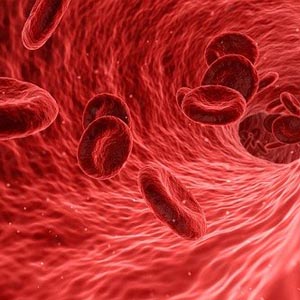The predictive value of inflammatory biomarkers in the detection of multiple sclerosis attacks

Accepted: 23 April 2023
All claims expressed in this article are solely those of the authors and do not necessarily represent those of their affiliated organizations, or those of the publisher, the editors and the reviewers. Any product that may be evaluated in this article or claim that may be made by its manufacturer is not guaranteed or endorsed by the publisher.
Multiple sclerosis (MS) is the most prevalent immune-mediated inflammatory demyelinating central nervous system disorder, with a diverse set of clinical signs and symptoms. This study aimed to investigate the diagnostic values of the monocyte/lymphocyte ratio (MLR), red cell distribution width/lymphocyte ratio (RLR), and systemic immune-inflammation index (SII) in detecting multiple sclerosis attacks in patients with Relapsing-remitting MS (RRMS) presenting to the emergency department (ED). This retrospective observational study was conducted among patients with RRMS presenting to the ED of a third-level hospital. The laboratory parameters of 165 patients were compared during the attack and non-attack periods. The paired t-test statistic was used to compare means of inflammatory biomarker measurements between attack and non-attack groups. The neutrophil/lymphocyte ratio (NLR), MLR, RLR, and SII mean of the patients in the MS attack periods were higher than those in the non-attack period. The mean difference of NLR, MLR, RLR, and SII between both groups was 5.40±7.25, 0.37±0.43, 7.77±11.61, 1469.19±1978.88, respectively (p<0.001). In ROC analysis, NLR, RLR, MLR, and SII had excellent diagnostic power in detecting MS relapse (AUC: 0.87, 0.81, 0.86, and 0.87, respectively). According to our findings, SII, MLR, NLR, and RLR may be beneficial in confirming the diagnosis of attack in patients with RRMS.
Reich DS, Lucchinetti CF, Calabresi PA. Multiple Sclerosis. Longo DL, editor. N Engl J Med 2018;378:169–80. DOI: https://doi.org/10.1056/NEJMra1401483
Hemmer B, Kerschensteiner M, Korn T. Role of the innate and adaptive immune responses in the course of multiple sclerosis. Lancet Neurol 2015;14:406–19. DOI: https://doi.org/10.1016/S1474-4422(14)70305-9
Inojosa H, Schriefer D, Ziemssen T. Clinical outcome measures in multiple sclerosis: A review. Autoimmun Rev 2020;19:102512. DOI: https://doi.org/10.1016/j.autrev.2020.102512
Olsson T, Barcellos LF, Alfredsson L. Interactions between genetic, lifestyle and environmental risk factors for multiple sclerosis. Nat Rev Neurol 2017;13:26–36. DOI: https://doi.org/10.1038/nrneurol.2016.187
D’Amico E, Zanghì A, Gastaldi M, et al. Placing CD20-targeted B cell depletion in multiple sclerosis therapeutic scenario: Present and future perspectives. Autoimmun Rev 2019;18:665–72. DOI: https://doi.org/10.1016/j.autrev.2019.05.003
De Bondt M, Hellings N, Opdenakker G, Struyf S. Neutrophils: Underestimated Players in the Pathogenesis of Multiple Sclerosis (MS). Int J Mol Sci 2020;21:1–25. DOI: https://doi.org/10.3390/ijms21124558
Olsson A, Gustavsen S, Gisselø Lauridsen K, et al. Neutrophil-to-lymphocyte ratio and CRP as biomarkers in multiple sclerosis: A systematic review. Acta Neurol Scand 2021;143:577–86. DOI: https://doi.org/10.1111/ane.13401
Hasselbalch IC, Søndergaard HB, Koch-Henriksen N, et al. The neutrophil-to-lymphocyte ratio is associated with multiple sclerosis. Mult Scler J - Exp Transl Clin 2018;4:2055217318813183. DOI: https://doi.org/10.1177/2055217318813183
Wang X, Qiu L, Li Z, et al. Understanding the multifaceted role of neutrophils in cancer and autoimmune diseases. Front Immunol 2018;9:2456. DOI: https://doi.org/10.3389/fimmu.2018.02456
D’amico E, Zanghì A, Romano A, et al. The neutrophil-to-lymphocyte ratio is related to disease activity in relapsing remitting multiple sclerosis. Cells 2019;8:1114. DOI: https://doi.org/10.3390/cells8101114
Demirci S, Demirci S, Kutluhan S, et al. The clinical significance of the neutrophil-to-lymphocyte ratio in multiple sclerosis. Int J Neurosci 2016;126:700–6.
Guzel I, Mungan S, Oztekin ZN, Ak F. Is there an association between the Expanded Disability Status Scale and inflammatory markers in multiple sclerosis? J Chin Med Assoc 2016;79:54–7. DOI: https://doi.org/10.1016/j.jcma.2015.08.010
Thompson AJ, Banwell BL, Barkhof F, et al. Diagnosis of multiple sclerosis: 2017 revisions of the McDonald criteria. Lancet Neurol 2018;17:162–73. DOI: https://doi.org/10.1016/S1474-4422(17)30470-2
Brownlee WJ, Hardy TA, Fazekas F, Miller DH. Diagnosis of multiple sclerosis: progress and challenges. Lancet 2017;389:1336–46. DOI: https://doi.org/10.1016/S0140-6736(16)30959-X
Yaşar E, Bayramoğlu A. Systemic ımmune-ınflammation ındex as a predictor of microvascular dysfunction in patients with cardiac syndrome X. Angiology 2022;73:615-21. DOI: https://doi.org/10.1177/00033197221087777
Norman G. Likert scales, levels of measurement and the “laws” of statistics. Adv Health Sci Educ Theory Pract 2010;15:625–32. DOI: https://doi.org/10.1007/s10459-010-9222-y
Ziemssen T, Akgün K, Brück W. Molecular biomarkers in multiple sclerosis. J Neuroinflammation 2019;16:1–11. DOI: https://doi.org/10.1186/s12974-019-1674-2
Dirican N, Anar C, Kaya S, et al. The clinical significance of hematologic parameters in patients with sarcoidosis. Clin Respir J 2016;10:32–9. DOI: https://doi.org/10.1111/crj.12178
Sen BB, Rifaioglu EN, Ekiz O, et al. Neutrophil to lymphocyte ratio as a measure of systemic inflammation in psoriasis. Cutan Ocul Toxicol 2014;33:223–7. DOI: https://doi.org/10.3109/15569527.2013.834498
Bisgaard AK, Pihl-Jensen G, Frederiksen JL. The neutrophil-to-lymphocyte ratio as disease actvity marker in multiple sclerosis and optic neuritis. Mult Scler Relat Disord 2017;18:213–7. DOI: https://doi.org/10.1016/j.msard.2017.10.009
Hutterer GC, Sobolev N, Ehrlich GC, et al. Pretreatment lymphocyte-monocyte ratio as a potential prognostic factor in a cohort of patients with upper tract urothelial carcinoma. J Clin Pathol 2015;68:351–5. DOI: https://doi.org/10.1136/jclinpath-2014-202658
Hemond CC, Glanz BI, Bakshi R, et al. The neutrophil-to-lymphocyte and monocyte-to-lymphocyte ratios are independently associated with neurological disability and brain atrophy in multiple sclerosis. BMC Neurol 2019;23:19. DOI: https://doi.org/10.1186/s12883-019-1245-2
Li S, Liu K, Gao Y, et al. Prognostic value of systemic immune–inflammation index in acute/subacute patients with cerebral venous sinus thrombosis. Stroke Vasc Neurol 2020;5:368. DOI: https://doi.org/10.1136/svn-2020-000362
de Carvalho Jennings Pereira WL, Flauzino T, Alfieri DF, et al. Immune-inflammatory, metabolic and hormonal biomarkers are associated with the clinical forms and disability progression in patients with multiple sclerosis: A follow-up study. J Neurol Sci 2020;410:116630. DOI: https://doi.org/10.1016/j.jns.2019.116630
Wu J, Zhang X, Liu H, et al. RDW, NLR and RLR in predicting liver failure and prognosis in patients with hepatitis E virus infection. Clin Biochem 2019;63:24–31. DOI: https://doi.org/10.1016/j.clinbiochem.2018.11.012
Meng J, Xu H, Liu X, et al. Increased red cell width distribution to lymphocyte ratio is a predictor of histologic severity in primary biliary cholangitis. Med (United States) 2018;97:48. DOI: https://doi.org/10.1097/MD.0000000000013431
Copyright (c) 2023 the Author(s)

This work is licensed under a Creative Commons Attribution-NonCommercial 4.0 International License.
PAGEPress has chosen to apply the Creative Commons Attribution NonCommercial 4.0 International License (CC BY-NC 4.0) to all manuscripts to be published.


 https://doi.org/10.4081/ecj.2023.11314
https://doi.org/10.4081/ecj.2023.11314







